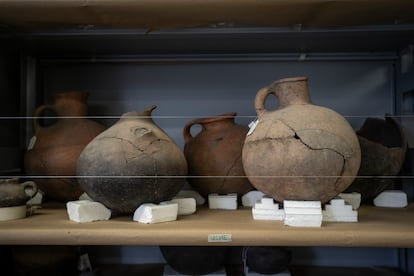What Bogotá’s first archaeological park reveals about our relationship with death
Now open to the public, Usme Archaeological Park is a space where excavations have found over 2,500 tombs dating back 1,200 years


For centuries, a rumor has circulated in Usme (south of Bogotá, Colombia) that the town had a piece of cursed land. It was said that it was the devil’s house, that children’s cries were constantly heard there and that strange lights appeared that made people who saw them disappear. These stories became so prevalent among the town’s residents that they even moved the foundation square a few meters to the south. In 2009, when several residents found archaeological remains in what is now a protected space and the Colombian capital’s first Archaeological Park, everything began to make a little more sense. “They were stories used by indigenous communities to protect a sacred place through fear,” says anthropologist Carolina Díaz, the project’s coordinator.
In mid-July, the first phase of Usme’s Archaeological and Cultural Heritage Park, the country’s eighth archaeological site, opened to the public. “The project seeks to help citizens [see] archeology as a way to understand the past and to vindicate all the forms of life present there,” Patrick Morales Thomas, the director of Bogota’s District Institute of Cultural Heritage, said on his way to the Hacienda del Carmen, the location of the archaeological treasures: 2,500 tombs and the remains of 10,000 indigenous people, in addition to 300,000 ceramic fragments and 45 pieces of pottery. “We want to make this a place that honors [our] ancestors and makes the people of Usme proud,” he added.
Beyond the dark tales told by the indigenous communities, Usme’s inhabitants themselves were the ones who saved this heritage. In 2008, this was land for urban expansion; the Metrovivienda company had begun to build a mega-city that sought to extend this rural area by over 900 hectares. The residents say that they were not consulted about the operation, and they note that, day after day, they saw the workers getting on the machinery to carefully observe the soil. Intrigued, they approached to see what they were so interested in. There, they found hundreds of skeletal remains and vessels that they took to community leader Jaime Beltrán. Together, they managed to stop the construction and created a working group to assess the next steps for forming the park.
For Díaz, this area is a piece of history through which to rethink everything: life, death and, above all, how we relate to both. Initially, because of the enormous amount of tombs and skeletal remains found there, experts considered the idea that this space was a Muisca cemetery. However, the number of domestic implements and the layout of the houses led them to reinterpret their hypothesis: it was not a cemetery, but rather indigenous communities in the past buried their ancestors in their homes and arranged their dwellings accordingly. “The living were not separated from the dead. There was a dialogue and a bond that was lost because of the colonial heritage,” says the anthropologist and resident. “Usme asks us a question: at what point did we begin to push the dead away instead of making them part of everyday life?”

Today, in this southern Bogotá town, the park coexists alongside a church in which the indigenous people who built it were also buried, and the town cemetery. “We are surrounded by corpses, and nobody talks about them,” adds Díaz. “Also, this is such a violent country that it is imperative to ask ourselves about death and about the space we give [our] ancestors in our lives.”
In this first phase, 49 informational signs have been installed in the park, allowing visitors to tour and discover southern Bogotá’s heritage. In addition, an investment of 6.3 billion pesos ($1.6 million) allowed for installing three domes that house an exhibition hall, a Circle of the Word and a community archeology laboratory, spaces that will continue to be part of participatory processes and management of the protected archeological area. A process of ecological restoration is now underway in which 20,000 trees have been planted, and a plan was made to recover the original flora and fauna.
The park is a huge piece of land surrounded by peasants’ houses, local crops and a half-built road. “As far as we know, no one has ever looked,” the residents repeat. A sculptural replica of a three-meter ceramic rattle dating to 700 AD-1000 AD presides over this space; in its original version, the rattle emitted a sound when a pebble was inserted. This anthropomorphic piece was found in a burial site as part of a 10-year-old girl’s trousseau. Alejandra Jaramillo, an anthropologist who specializes in differential and gender approaches, explains to the first visitors the importance of the items they found: “It is a piece that allows us to reflect on the different layers of meaning that an archaeological object can have. On the one hand, it tells us about childhood. It is a toy that was used to lull the child to sleep and accompanies her even in death. On the other hand, on the upper part of the figure’s head, we can see a splint that alludes to the practice of cranial deformation among the groups of the Bogotá savanna, [it was] an expression of status and beauty; at the time, it was an aesthetic modification.”
Francisco Romano, one of the archaeologists overseeing this project, reflects the passion surrounding this research: “Our job is to figure it out. Every time we did another excavation, we had more material to ask questions about the past, about our past.” He sips red wine in a peasant family’s home at the entrance of Hacienda del Carmen. “You have a treasure next door,” he tells them excitedly. According to Jaramillo, this is a place that tells the story of several generations: “People lived here, had social, economic and political dynamics, traded and exchanged with people from other regions of Colombia. And, once they died, their memories were captured in funerary contexts.”
This park is the result of the local communities’ efforts to protect and preserve their rural area. And they are the ones who are deciding what will happen after the first phase. That is not an easy task. In addition to requiring the expertise of archaeologists, each phase involves several indigenous communities and local farmers. “This is a project that they have to decide,” says Morales. Of the multiple possibilities, three options seem to stand out.

The first is to make it a sacred park and not allow interventions there. Several indigenous communities claim it as a symbol of erased memories and ancestry and refuse to allow it to be accessed. On the other hand, there is an interest in education, which seeks to turn the area into a pedagogical site that talks about science and indigenous knowledge. Finally, it may represent an opportunity for the local economy and community tourism. “Many people [are] against that [idea] because we have [seen] several examples of tourism that destroys the ecosystem,” says Díaz. “But [there] may be a way to rethink it and tailor it to the community’s needs. There are a lot of conversations still to [be had].”
According to Morales, this is the first of many steps. “We have a responsibility to have these conversations and [determine] how this special place is accessed or not. For now, we are celebrating having found a treasure that will add value to the south of Bogotá.”
Sign up for our weekly newsletter to get more English-language news coverage from EL PAÍS USA Edition
Tu suscripción se está usando en otro dispositivo
¿Quieres añadir otro usuario a tu suscripción?
Si continúas leyendo en este dispositivo, no se podrá leer en el otro.
FlechaTu suscripción se está usando en otro dispositivo y solo puedes acceder a EL PAÍS desde un dispositivo a la vez.
Si quieres compartir tu cuenta, cambia tu suscripción a la modalidad Premium, así podrás añadir otro usuario. Cada uno accederá con su propia cuenta de email, lo que os permitirá personalizar vuestra experiencia en EL PAÍS.
¿Tienes una suscripción de empresa? Accede aquí para contratar más cuentas.
En el caso de no saber quién está usando tu cuenta, te recomendamos cambiar tu contraseña aquí.
Si decides continuar compartiendo tu cuenta, este mensaje se mostrará en tu dispositivo y en el de la otra persona que está usando tu cuenta de forma indefinida, afectando a tu experiencia de lectura. Puedes consultar aquí los términos y condiciones de la suscripción digital.
More information
Archived In
Últimas noticias
Most viewed
- Reinhard Genzel, Nobel laureate in physics: ‘One-minute videos will never give you the truth’
- Oona Chaplin: ‘I told James Cameron that I was living in a treehouse and starting a permaculture project with a friend’
- Pablo Escobar’s hippos: A serious environmental problem, 40 years on
- Charles Dubouloz, mountaineering star, retires at 36 with a farewell tour inspired by Walter Bonatti
- Why we lost the habit of sleeping in two segments and how that changed our sense of time









































